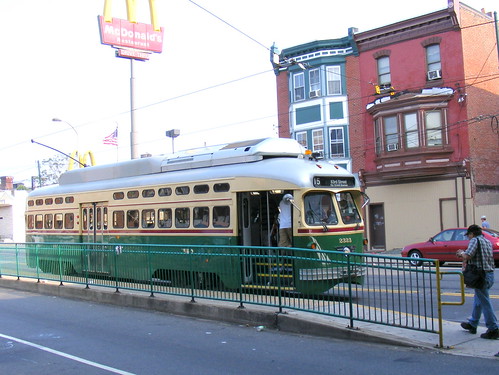 A PCC-II Streetcar on the 15 Girard Route
A PCC-II Streetcar on the 15 Girard Route
After my visit to New York City, where I visited Times Square and the new High Line Park (amongst other things), I moved on to Philadelphia, where one of my aims was to try out the South East Pennsylvania Transit Authority (SEPTA) system. SEPTA is rather unique as it operates six different transit modes in the Metro Philadelphia area: diesel bus, trolley bus, streetcar, subway (and elevated), regional rail, and an unique interurban “high-speed” line. SEPTA runs a true legacy system – there’s very little new transit infrastructure at all in this city (apart from a downtown regional rail tunnel and a line to the airport, more on that below the fold), but a collection of different services melded into one. The only transit services in Philadelphia not operated by SEPTA are the commuter-subway PATCO Speedline to New Jersey as well as NJ Transit buses serving the communities on the other side of the Delaware River.
Most of the streetcars (called trolleys there) run in a partial subway downtown, much like the MBTA Green Line in Boston or the MUNI Metro in San Francisco, but two routes (the 101 and 102) are legacies of a suburban trolley system, and one, the 15-Girard, runs using restored PCC equipment.
Despite being purchased by National City Lines, the abandonment of Philly’s expansive trolley network was never completed. In the 1960s the state-formed SEPTA took over the NCL-owned Philadelphia Transportation Company. At the same time, it took over the responsibility for the Reading and Pennsylvania Railroads’ commuter services and the various suburban services. In the 1970s, Philadelphia still had 6 surface trolley routes and 5 subway-surface routes, as well as two suburban trolleys; but by 1992, all surface routes were busituted, partly due to the deterioration of the PCC fleet.
In 2005, service resumed on the 15 Girard Route. The infrastructure was rebuilt (though all wire and tracks from the 1992 abandonment are all in place) and 18 PCCs were completely rebuilt, with modern interiors, wheelchair lifts, air conditioning (and sealed windows), and the historic PTC colour scheme. The streetcars service the near north end and Delaware River shore, a transitional area between the poorer North Philly and downtown, and an area of gentrification. Two other routes, the 56 Erie and 23 Germantown (perhaps the longest streetcar route in the United States), are pending reconstruction.  Surface streetcars were not the only mode of transport in Philly to be abandoned and resurrected. Trolley buses (known there as “trackless trolleys”) replaced some streetcars in the 1940s and 1950s, but were scrapped in 2003. Last year, new trolley buses were returned to 3 of the 5 routes (the other two, served by a separate depot, were ignored). I, personally, would like to see trolley buses returned to Toronto, and Philadelphia at least provides some modern precedent to the restoration of this clean, efficient mode of transit.
Surface streetcars were not the only mode of transport in Philly to be abandoned and resurrected. Trolley buses (known there as “trackless trolleys”) replaced some streetcars in the 1940s and 1950s, but were scrapped in 2003. Last year, new trolley buses were returned to 3 of the 5 routes (the other two, served by a separate depot, were ignored). I, personally, would like to see trolley buses returned to Toronto, and Philadelphia at least provides some modern precedent to the restoration of this clean, efficient mode of transit.
SEPTA also operates an interesting regional rail system, of which most routes run on weekends and off-peak weekdays. All lines are electric, due to work done much by both the Reading and Pennsylvania Railroads. A project completed in 1985 consolidated the two systems and saw a four track railway tunnel completed through the downtown core. With the trunking of regional lines together, there is a bit of a S-Bahn or RER style of operation, though schedules are quite inferior. A spur to the airport was constructed as well, allowing for an inexpensive, half-hourly, 20-minute direct ride from each airport terminal to the central city. Imagine GO Transit operating such an inexpensive, direct service off a short spur from an existing rail line. Wouldn’t that be lunacy?
Finally, the other thing to note is that in their downtown headquarters, SEPTA operates a small museum and a gift shop selling SEPTA-branded merchandise as well as books and general model railroading stuff and toys. An unrefurbished (but repainted) PCC car, historical maps and interpretive displays are on display. While the TTC may not be interested in running a full museum (the Halton County Railway Museum fills that role), a small museum like SEPTA’s or the MTA Museum Annex in Grand Central Station would be a great idea to include in the Union Station renovations to cater to tourists and local transit enthusiasts.
Below, a few more random pictures:
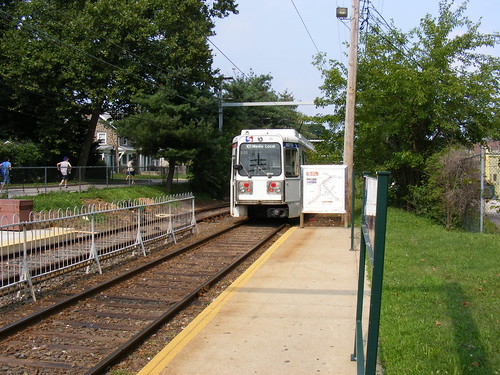 The suburban trolley stop at Drexel Hill
The suburban trolley stop at Drexel Hill
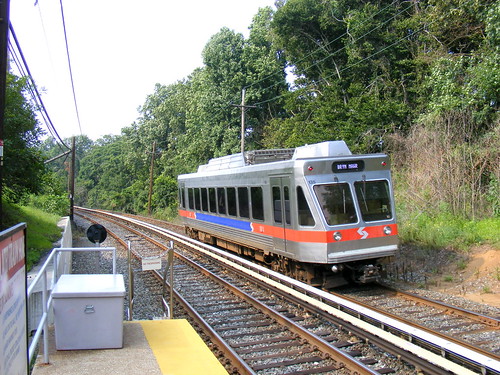 The Norristown High-Speed Line, perhaps one of two (along with Chicago’s South Shore Line) remaining interurbans in North America
The Norristown High-Speed Line, perhaps one of two (along with Chicago’s South Shore Line) remaining interurbans in North America
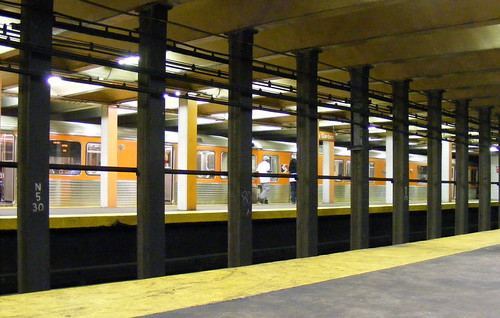 I found the Broad Street Subway to be very depressing (coupled with a long evening wait). Note the express tracks.
I found the Broad Street Subway to be very depressing (coupled with a long evening wait). Note the express tracks.



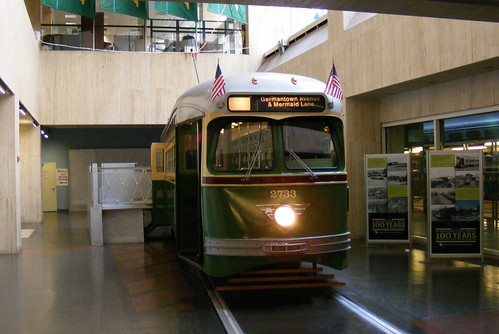

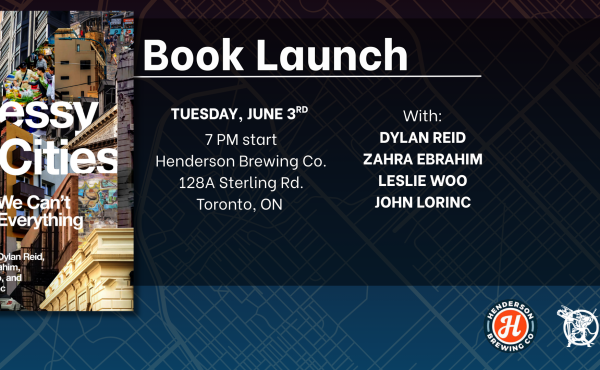

8 comments
You forgot to mention the 1975 fire that destroyed 60 PCC’s, and in which half were replaced by PCC’s from Toronto.
Sigh. The first shot brings back memories of the comfortable old TTC streetcars. Remember the ones with padding on the seats?
Since the Philadelphia cars “were completely rebuilt, with modern interiors”, they are probably no better than ours, though. Steel seats with a fig leaf of fabric glued on.
Yes, Philadelphia has and has always had many modes of transportation. However, Septa’s prioty seems to go to buses. The new buses bought by Septa are the most uncomfortable that I have ever experienced. Their design creates problems inside the bus near the entrance doors where there are areas to place small packages. Crime being what it is in most parts of the city, no sane person is going to leave his belongings in one part of the bus and sit in another. Also the aisles are too narrow.
Septa has two additional streetcar routes, 23 and 56,which were converted to bus on a temporary basis in the mid 1990’s. New cars were to be bought for the surface car subway and the older cars purchased in 1981 would be shifted to these routes. Septa neither updated nor maintained the infrastructure on these routes
Routes 29 and 79, trolleybus routes have received the same treatment. They too were converted to bus until new vehicles were bought.
The Broad Street Subway is certainly worth the two dollar fare. Yes, at night the wait can be long; however, during the day there are two express and one local routes. The express train can carry one from Walnut-Lucust station to Fern Rock station in about 18 minutes while making seven stops.
I hope in the future that Septa returns to rail transit because the streetcars hold more people, are more confortable,and can traverse the narrow streets of Philadelphia better than buses.
Another aspect of Philadelphia which couldn’t help but remind me of Toronto was the presence of TD banks! They were very common in Center City/University City.
Thanks for the excellent photos and article. I’ve always felt that Philly’s extensive transit net is somewhat underappreciated. If the city were not the economic wreck that it is, SEPTA would have a much higher profile (along with better service frequency and less crime). I’ve commented before that Toronto would do very, very well indeed if GO was as comprehensive as Regional Rail. True, the subway is a bit of a mess, but think of it as the New York Subway circa 1983. (The bones of an excellent system are there.) As for the fact that we sold our restored PCCs to fricking Wisconsin while bankrupt Philly, of all places, managed to bring theirs back… a disgrace.
PS- Hah, the TD Banks are former Commerce Banks that are now, post mortgage-mess, owned by TD Banknorth, which recently decided to rebrand both companies as good old TD Bank. They are all over NJ and NY also. It’s a little like Toronto pre-Canada Trust merger.
PPS- There is one other surviving interurban, the Mattapan line in Boston. Pittsburgh may also count depending on your definition.
The Pittsburgh line is definitely an old interurban, although it (along with the system in that town) is a shadow of what it once was.
Also don’t forget Chicago where some lines we would think of as “subways” are old interurban routes.
Philly is a very sad example of what happens when a system is starved for money. Maintenance and service fall off and cuts this year become the new base budget next year. Undoing the damage is a huge task.
Excellent piece Sean! I can’t think of much to add except to say that I too was in Philly recently and found one peculiarity of their system to be their “downtown transit concourse.” It’s basically a giant concourse under Broad Street that connects a bunch of the downtown stations together. Strangely though, it has no retail, so it’s this massively long and most of the day fairly empty giant concourse.
There’s a pic I took of it here: http://farm4.static.flickr.com/3602/3623926439_58ebee6fd3.jpg
My girlfriend and I just rode the refurbished Girard Ave PCC-II trolley over the weekend, and it was a joy to ride. The cloth-covered seats were comfortable, the interior was updated and a lot less “industrial” than a bus interior, and the fresh paint and tinted windows gave it kind of a sleek look. We chatted with the trolley driver during the trip and he was quite friendly.
I think there’s a welcoming factor to trolleys / streetcars for city visitors that buses do not posess. The sense of “permanence” of the tracks and the ability of a rider to see where they are going give a little bit more reassurance that you know where it is going.
At any rate, our destination was the Modo Mio restaurant on Girard Ave, which I highly recommend. Just make sure you make your reservation about a month in advance.
Ken